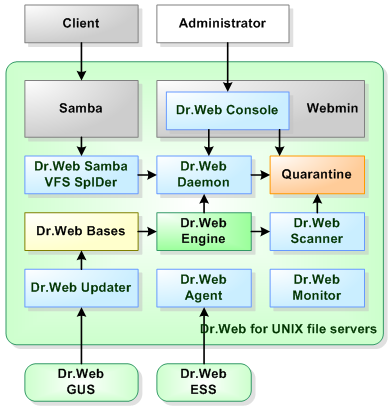This Manual describes the following anti-virus software (version 6.0.2):
•Dr.Web® Anti-virus for UNIX File Servers for Linux;
•Dr.Web® Anti-virus for UNIX File Servers for FreeBSD;
•Dr.Web® Anti-virus for UNIX File Servers for Solaris x86.
As far as all these solutions for UNIX systems differ from each other only slightly, all of them will be referred to as Dr.Web for UNIX File Servers. Critical differences are described in the corresponding chapters and paragraphs.
The manual is designed for a person responsible for anti-virus protection and security ("Administrator" hereinafter).
Protection of UNIX file servers involves detection and neutralization of viruses and other malware. Although most malware is designed for non-UNIX systems, viruses for other operating systems and macro-viruses for applications can spread via local networks.
Virus check is made when a server performs a requested file operation (i.e. writing or reading files on the server).
Dr.Web for UNIX File Servers includes the following components:
•Dr.Web Scanner - console anti-virus scanner that provides detection and neutralization of viruses on the local machine and in the shared directories;
•Dr.Web Daemon - a background that performs functions of an external anti-virus filter;
•Dr.Web Monitor - a resident component that runs and terminates other Dr.Web modules in the required order;
•Dr.Web Agent - a resident component that helps to configure and manage Dr.Web components, gathers statistics and provides integration with Dr.Web Enterprise Security Suite (Dr.Web ESS);
|
By default, the solution includes Dr.Web Agent, designed for integration with Dr.Web ESS 6.0. If you want to integrate the suite with Dr.Web ESS 10.0, install the updates for Dr.Web Agent and perform additional configuration steps. For details, refer to the Dr.Web Agent section. |
•Dr.Web Engine and virus databases that are regularly updated;
•Dr.Web Updater (implemented as a Perl script) - a component that provides regular updates to virus databases;
•Dr.Web Samba VFS SpIDer - a resident component that monitors file operations. The component is implemented as a plug-in for a VFS interface (Virtual File System) in Samba. It serves as a client for Dr.Web Daemon and integrates all other packages with Samba file servers;
•Dr.Web Console for UNIX File Servers – web management interface, a Webmin built-in module, used for Dr.Web for UNIX File Servers management and configuration via the web interface from any browser.
The following picture shows the structure of Dr.Web for UNIX File Servers and its components.

Figure 1. Structure of Dr.Web for UNIX File Servers and its components
The present manual provides information on setup, configuration, and usage of Dr.Web for UNIX File Servers, that is:
•General product description
•Installation of Dr.Web for UNIX File Servers
•Running Dr.Web for UNIX File Servers
•Usage of Dr.Web Updater
•Usage of Dr.Web Agent
•Usage of console scanner Dr.Web Scanner
•Usage of background on-demand scanner Dr.Web Daemon
•Usage of Dr.Web Monitor
•Integrating Dr.Web Samba VFS SpIDer with Samba file servers
•Usage of Dr.Web Console for UNIX File Servers web interface for Dr.Web for UNIX File Servers configuration
At the end of this manual, you can find contact information for technical support.
Doctor Web products are constantly developed. Updates to virus databases are issued daily or even several times a day. New product versions appear. They include enhancements to detection methods, as well as to the means of integration with UNIX systems. Moreover, the list of applications compatible with Doctor Web is constantly expanding. Therefore, some settings and functions described in this Manual can slightly differ from those in the current program version. For details on updated program features, refer to the documentation delivered with an update.